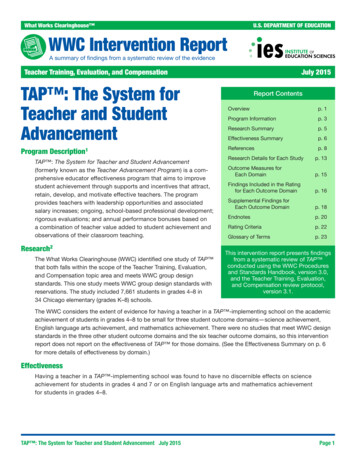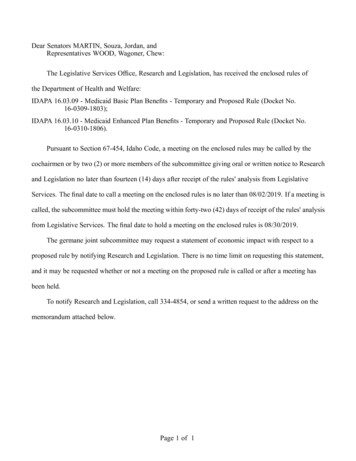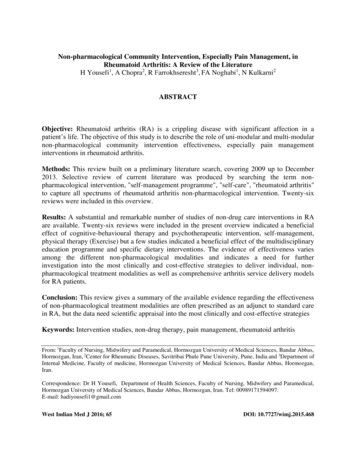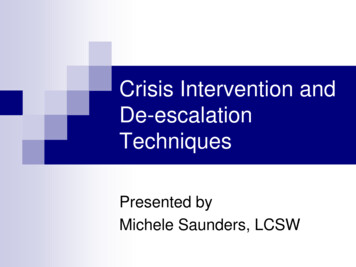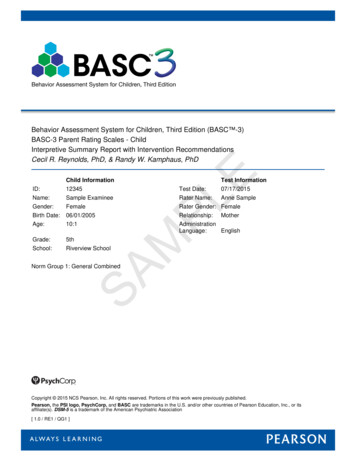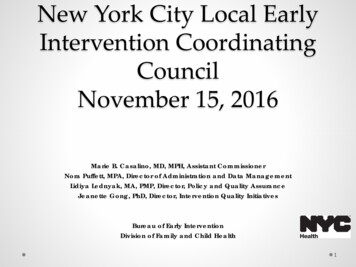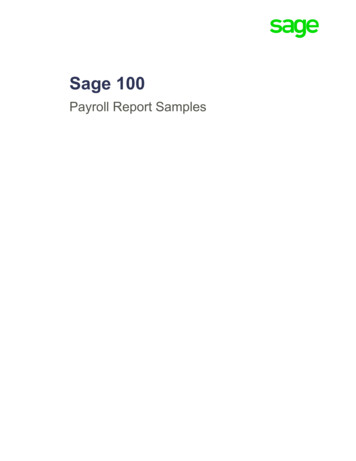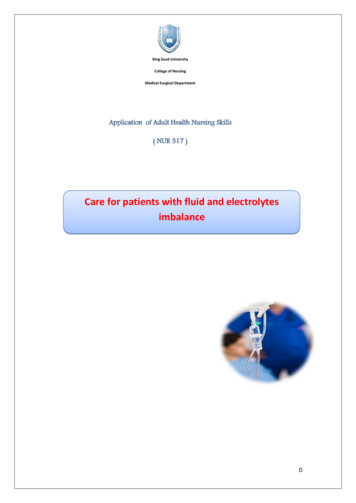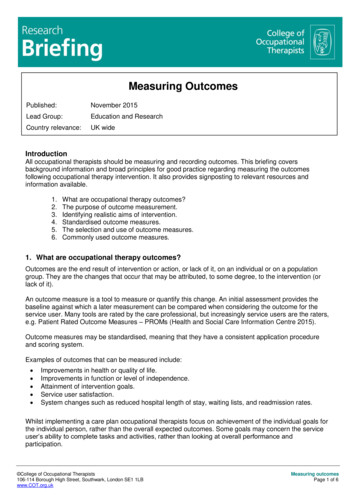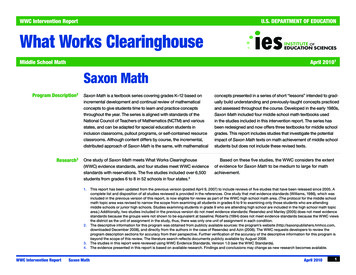
Transcription
WWC Intervention ReportU.S. DEPARTMENT OF EDUCATIONWhat Works ClearinghouseMiddle School MathApril 20101Saxon MathProgram Description2Saxon Math is a textbook series covering grades K–12 based onincremental development and continual review of mathematicalconcepts to give students time to learn and practice conceptsthroughout the year. The series is aligned with standards of theNational Council of Teachers of Mathematics (NCTM) and variousstates, and can be adapted for special education students ininclusion classrooms, pullout programs, or self-contained resourceclassrooms. Although content differs by course, the incremental,distributed approach of Saxon Math is the same, with mathematicalconcepts presented in a series of short “lessons” intended to gradually build understanding and previously-taught concepts practicedand assessed throughout the course. Developed in the early 1980s,Saxon Math included four middle school math textbooks usedin the studies included in this intervention report. The series hasbeen redesigned and now offers three textbooks for middle schoolgrades. This report includes studies that investigate the potentialimpact of Saxon Math texts on math achievement of middle schoolstudents but does not include these revised texts.Research3One study of Saxon Math meets What Works Clearinghouse(WWC) evidence standards, and four studies meet WWC evidencestandards with reservations. The five studies included over 6,500students from grades 6 to 8 in 52 schools in four states.4Based on these five studies, the WWC considers the extentof evidence for Saxon Math to be medium to large for mathachievement.1.2.3.4.WWC Intervention ReportSaxon MathThis report has been updated from the previous version (posted April 9, 2007) to include reviews of five studies that have been released since 2005. Acomplete list and disposition of all studies reviewed is provided in the references. One study that met evidence standards (Williams, 1986), which wasincluded in the previous version of this report, is now eligible for review as part of the WWC high school math area. (The protocol for the middle schoolmath topic area was revised to narrow the scope from examining all students in grades 6 to 9 to examining only those students who are attendingmiddle schools or junior high schools. Studies examining students in grade 9 who are attending high school are included in the high school math topicarea.) Additionally, two studies included in the previous version do not meet evidence standards: Resendez and Manley (2005) does not meet evidencestandards because the groups were not shown to be equivalent at baseline; Roberts (1994) does not meet evidence standards because the WWC viewsthe district as the unit of assignment in the study, thus, there was only one unit of assignment in each condition.The descriptive information for this program was obtained from publicly available sources: the program’s website (http://saxonpublishers.hmhco.com,downloaded December 2008), and directly from the authors in the case of Resendez and Azin (2006). The WWC requests developers to review theprogram description sections for accuracy from their perspective. Further verification of the accuracy of the descriptive information for this program isbeyond the scope of this review. The literature search reflects documents publicly available by August 2008.The studies in this report were reviewed using WWC Evidence Standards, Version 1.0 (see the WWC Standards).The evidence presented in this report is based on available research. Findings and conclusions may change as new research becomes available.April 20101
EffectivenessSaxon Math was found to have mixed effects on math achievement.Math achievementRating of effectivenessImprovement index5Mixed effectsAverage: 9 percentile pointsRange: 6 to 16 percentile pointsAdditional programinformationDeveloper and contactOriginally developed by John Saxon, Saxon Math is distributedby Houghton Mifflin Harcourt Supplemental Publishers. Address:Harcourt Achieve, Attn: Customer Service, 5th Floor, 6277 SeaHarbor Drive, Orlando, FL 32887. Email: info@SaxonPublishers.com. Web: http://saxonpublishers.hmhco.com. Telephone: (800)531-5015.Scope of useSaxon Math’s first textbook (Algebra I for ninth grade) waspublished in 1980. By 1986, four books were available: Algebra 1,Algebra 2, Algebra ½, and Advanced Mathematics. By 1993, thecompany had published 13 books and programs for students inkindergarten through high school.Currently, there are three textbooks used to teach middleschool math: Saxon Math Course 1 for grade 6, Saxon MathCourse 2 for grade 7, and Saxon Math Course 3 for grade 8.Information regarding the number and demographics of students,schools, or districts currently using Saxon Math is not available.ResearchNineteen studies reviewed by the WWC investigated theeffects of Saxon Math. One study (Resendez & Azin, 2006)is a randomized controlled trial that meets WWC evidencestandards. Four studies (Peters, 1992; Crawford & Raia, 1986;5.WWC Intervention ReportSaxon MathTeachingThe Saxon Math curriculum for each grade level consists of atleast 120 daily lessons and 12 activity-based investigations. Adaily lesson consists of warm-up activities (10–15 minutes) forbuilding automatic recall of math foundations, computationalskills and facts, number sense, and problem solving; introductionto the new concept (5–10 minutes); and distributed practice tostrengthen understanding of previously learned concepts (20–30minutes). Cumulative assessments are given after every five lessons. Saxon Math can be adapted for special education or homeschooled students.CostEach two-volume Teacher’s Manual costs 96.15, and eachstudent edition textbook costs between 56 and 59. Otheravailable materials include posters, manipulatives, and guidesfor adapting the Saxon Math curriculum for special educationstudents.Resendez, Fahmy, & Manley, 2005, Cohort A; and Resendez,Fahmy, & Manley, 2005, Cohort F) are randomized controlledtrials or quasi-experimental designs that meet WWC evidencestandards with reservations. Two of these studies (Resendez,These numbers show the average and range of student-level improvement indices for all findings across the studies.April 20102
Research (continued)Fahmy, & Manley, 2005, Cohort A and Resendez, Fahmy, &Manley, 2005, Cohort F) were included within one researchreport.6 The remaining 14 studies do not meet either WWCevidence standards or eligibility screens.Meets evidence standardsResendez and Azin (2006) conducted a randomized controlledtrial to investigate the effect of Saxon Math on math achievementin one northeastern Ohio middle school and one southwesternOhio junior high school.7 The schools served sixth-, seventh-, andeighth-grade students living in urban and suburban locations;classes were randomly assigned to use Saxon Math or controlcurricula during the 2005–06 school year. The analysis sampleincluded 14 Saxon Math classrooms (approximately 260 students)and 11 control classrooms (more than 200 students). Classesin the intervention group used one of four Saxon Math curricula(Saxon 7/6, 2004-4th Ed.; Saxon 8/7, 2004-4th Ed.; Saxon Algebra½, 2004-3rd Ed.; or Saxon Algebra 1, 2003-3rd Ed.); classes in thecontrol group used either a traditional basal program or a mixedcurriculum consisting primarily of teacher-created materials.Meets evidence standards with reservationsPeters (1992) conducted a randomized controlled trial that hadnon-random allocations after random assignment to investigate6.7.8.9.WWC Intervention ReportSaxon Maththe effect of Saxon Math on math achievement of 36 “mathtalented” eighth-grade students from one junior high school inNebraska during the 1991–92 school year.8,9 The district borderstwo large cities (Lincoln and Omaha) and its students lived inrural and suburban areas. Students in the intervention groupused the Saxon Algebra 1 textbook (1981), while students inthe comparison group used the University of Chicago SchoolMathematics Project (UCSMP) Algebra first-edition textbook.Crawford and Raia (1986) conducted a within-teacher,matched-comparison quasi-experiment to investigate the effectof Saxon Math on math achievement of eighth-grade students inOklahoma City Public Schools during the 1984–85 school year.The analysis sample included 78 eighth-grade students (39 Saxonand 39 comparison) taught by four teachers from four middleschools. Students in the intervention group used the SaxonAlgebra ½ (1983) textbook, and students in the comparison groupused the Scott-Foresman Mathematics (1980) textbook.Resendez, Fahmy, and Manley (2005, Cohort A) conducteda quasi-experiment to investigate the effect of Saxon Math onmath achievement in 25 middle schools serving sixth-, seventh-,and eighth-grade students in rural, suburban, and urban districtsin Texas. The analysis sample for Cohort A (grade 8 of Sample1) included 1,472 students from 12 intervention schools whoreceived three years of Saxon Math exposure in grades 6, 7,The study authors reported on three independent samples containing multiple cohorts of students. Sample 2 was excluded from WWC review becausethis sample was used for a pre-post analysis of the students in Saxon Math schools and did not include a comparison group. Cohorts B and C ofSample 1 were included only in an analysis of tenth-grade math performance. Because it is unknown whether the intervention and comparison groupsfor these cohorts attended similar schools in grades 9 and 10, it is impossible to determine whether the effects can be attributed solely to Saxon Math;therefore, the WWC excluded these cohorts from this review. Cohorts G and H of Sample 3 were excluded because pre-Saxon math achievement datawere not available for these students and, consequently, baseline equivalence could not be established. Cohort A (grade 8 of Sample 1) and Cohort F(grade 6 of Sample 3) were treated as separate studies because they examined the effects of Saxon Math on different samples of students at two different times. Students in Cohort A were in grade 8 in 2000–01; students in Cohort F were in grade 6 in 2003–04.In the case of Resendez and Azin (2006), differences between intervention and control groups on pretest, and several demographic characteristics,were statistically significant at the student level but not at the classroom level. The study authors statistically controlled for these baseline differences intheir analysis. Because random assignment was well executed, the WWC categorizes the study as a randomized controlled trial.Peters (1992) compared Saxon Math with UCSMP Algebra. The author indicates that a random selection of numbers was used to divide participantsbetween the intervention and comparison groups. However, the assignment of students was altered to accommodate scheduling difficulties and studentrequests for other course offerings. Therefore, the study meets standards with reservations, according to WWC criteria.The “math-talented” designation is based on teacher recommendations and prior academic achievement. No information is provided on the specificthresholds that were used in delineating the math-talented criteria; however, all students in the sample scored at or above the 87th percentile on theCalifornia Achievement Test total math battery.April 20103
Research (continued)Effectivenessand 8 and 1,582 students from 13 comparison schools duringthe 1998–99 through 2000–01 school years. Schools in theintervention group used three Saxon Math curricula (Saxon 7/6,Saxon 8/7, or Saxon Algebra ½); the majority of schools in thecomparison group used core basal math curricula, which typically consist of a chapter-based approach to math instruction.10Resendez, Fahmy, and Manley (2005, Cohort F) conducteda quasi-experiment to investigate the effect of Saxon Mathon math achievement in 20 middle schools serving sixth-,seventh-, and eighth-grade students in rural, suburban, andurban districts in Texas. The analysis sample for Cohort F(grade 6 of Sample 3) included 1,526 sixth-grade students fromten intervention schools who received one year of Saxon Mathexposure and 1,407 students from ten comparison schools during the 2003–04 school year. Schools in the intervention groupFindingsThe WWC review of interventions for Middle School Mathaddresses student outcomes in the math achievement domain.The findings below present the authors’ estimates and WWCcalculated estimates of the size and the statistical significance ofthe effects of Saxon Math on students.12Math AchievementResendez and Azin (2006) reported positive but not statistically significant effects of Saxon Math on math achievementbased on TerraNova Math Total and TerraNova Math Computation Total test scores. The effect sizes calculated by theused two Saxon Math curricula (Saxon 7/6 or Saxon 8/7); themajority of schools in the comparison group used core basalmath curricula, which typically consist of a chapter-basedapproach to math instruction.10Extent of evidenceThe WWC categorizes the extent of evidence in each domain assmall or medium to large (see the WWC Procedures and Standards Handbook, Appendix G). The extent of evidence takes intoaccount the number of studies and the total sample size acrossthe studies that meet WWC evidence standards with or withoutreservations.11The WWC considers the extent of evidence for Saxon Math tobe medium to large for math achievement.WWC were not large enough to be considered substantivelyimportant according to WWC criteria (an effect size of atleast 0.25).13Peters (1992) reported a positive but not statistically significant effect of Saxon Math on math achievement based onOrleans-Hanna Prognosis Test test scores. The effect size wasnot large enough to be considered substantively important byWWC criteria (an effect size of at least 0.25).Crawford and Raia (1986) reported a positive and statisticallysignificant effect of Saxon Math on math achievement basedon California Achievement Test (CAT) Total Math test scores.The statistical significance of this effect was not confirmed by10. The authors did not provide information on the edition and publication year of the Saxon Math texts used in the study.11. The extent of evidence categorization was developed to assess how much evidence was used to determine the intervention rating, focusing on thenumber and size of studies. Additional factors associated with a related concept—external validity, such as the students’ demographics and the typesof settings in which studies took place—are not taken into account for the categorization. Information about how the extent of evidence rating wasdetermined for Saxon Math is in Appendix A6.12. The level of statistical significance was reported by the study authors or, when necessary, calculated by the WWC to correct for clustering withinclassrooms or schools and for multiple comparisons. For an explanation, see the WWC Tutorial on Mismatch. For the formulas the WWC used tocalculate the statistical significance, see WWC Procedures and Standards Handbook, Appendix C for clustering and WWC Procedures and StandardsHandbook, Appendix D for multiple comparisons. Corrections for clustering were conducted for both analysis samples included from Resendez, Fahmy,and Manley (2005). No studies required corrections for multiple comparisons.13. The effect size formula used by Resendez and Azin (2006) differs from the formula used by the WWC and yields a different effect size.WWC Intervention ReportSaxon MathApril 20104
Effectiveness (continued)The WWC found Saxon Mathto have mixed effects formath achievementWWC analysis.14 However, the effect size was large enough to beconsidered substantively important according to WWC criteria(an effect size of at least 0.25).Resendez, Fahmy, and Manley (2005, Cohort A) reporteda positive and statistically significant effect of Saxon Math forthe grade 8 cohort on math achievement based on the TexasAssessment of Academic Skills (TAAS) math scores. Afteraccounting for the use of different levels of assignment andanalysis, the WWC determined this finding was not statisticallysignificant or large enough to be considered substantivelyimportant by WWC criteria (an effect size of at least 0.25).Resendez, Fahmy, and Manley (2005, Cohort F) reporteda positive and statistically significant effect of Saxon Math forthe grade 6 cohort on math achievement based on the TexasAssessment of Knowledge and Skills (TAKS) math test. Afteraccounting for the use of different levels of assignment andanalysis, the WWC determined that this finding was not statistically significant, but the effect size was large enough to beconsidered substantively important according to WWC criteria(an effect size of at least 0.25).In sum, in the math achievement domain, the WWC reviewedfindings from five studies. Two of these studies showed substantively important positive effects, and the remaining three studiesshowed indeterminate effects. One study used a strong design.Improvement indexThe WWC computes an improvement index for each individualfinding. In addition, within each outcome domain, the WWCcomputes an average improvement index for each study and anaverage improvement index across studies (see WWC Proceduresand Standards Handbook, Appendix F). The improvement indexrepresents the difference between the percentile rank of the average student in the intervention condition and the percentile rank ofthe average student in the comparison condition. Unlike the ratingof effectiveness, the improvement index is entirely based on thesize of the effect, regardless of the statistical significance of theeffect, the study design, or the analysis. The improvement indexcan take on values between –50 and 50, with positive numbersdenoting favorable results for the intervention group.The average improvement index for math achievement is 9percentile points across the five studies, with a range of 6 to 16 percentile points across findings.Rating of effectivenessThe WWC rates the effects of an intervention in a given outcomedomain as positive, potentially positive, mixed, no discernibleeffects, potentially negative, or negative. The rating of effectiveness takes into account four factors: the quality of the researchdesign, the statistical significance of the findings, the size ofthe difference between participants in the intervention and thecomparison conditions, and the consistency in findings acrossstudies (see the WWC Procedures and Standards Handbook,Appendix E).SummaryThe WWC reviewed 19 studies on Saxon Math. One studymeets WWC evidence standards; four studies meet WWCevidence standards with reservations; the remaining 14 studies do not meet either WWC evidence standards or eligibilityscreens. Based on the five studies, the WWC found mixedeffects on math achievement. The conclusions presented inthis report may change as new research emerges.14. Crawford and Raia (1986) reported, and the WWC confirmed, that there was not a statistically significant difference in posttest means between theSaxon Math and comparison groups and that the two groups had identical pretest means. In an additional analysis, the authors reported that controllingfor pretest produced a statistically significant effect of Saxon Math; the WWC could not confirm the reported significance level for this analysis, andWWC calculations indicated the effect was not statistically significant.WWC Intervention ReportSaxon MathApril 20105
ReferencesMeets WWC evidence standardsResendez, M., & Azin, M. (2006). Saxon Math randomized controltrial: Final report. Jackson, WY: PRES Associates, Inc.Meets WWC evidence standards with reservationsCrawford, J., & Raia, F. (1986). Analyses of eighth grade mathtexts and achievement. Oklahoma City, OK: OklahomaCity Public Schools, Planning, Research, and EvaluationDepartment.Peters, K. G. (1992). Skill performance comparability of twoalgebra programs on an eighth-grade population. DissertationAbstracts International, 54(01), 77A. (UMI No. 9314428)Resendez, M., Fahmy, A., & Manley, M. A. (2005). Cohort A. Therelationship between using Saxon Middle School Math andstudent performance on Texas statewide assessments. Available online from Harcourt Achieve: df/s/SXMath Middle TXresearch web.pdf. (Cohort A).Resendez, M., Fahmy, A., & Manley, M. A. (2005). Cohort F. Therelationship between using Saxon Middle School Math andstudent performance on Texas statewide assessments. Available online from Harcourt Achieve: df/s/SXMath Middle TXresearch web.pdf. (Cohort F).Studies that fall outside the Middle School Math reviewprotocol or do not meet WWC evidence standardsAndrus, H. A. (2005). Metacognitive instruction in the realm ofsixth grade Saxon Math. Unpublished doctoral dissertation,Mount Mary College, Milwaukee, WI. The study is ineligible forreview because it does not use a comparison group.Baldree, C. L. P. (2003). The effectiveness of two mathematicalinstructional programs on the mathematics growth of eighthgrade students. Unpublished doctoral dissertation, Universityof Georgia, Athens. The study does not meet WWC evidencestandards because the intervention and comparison groupsare not shown to be equivalent at baseline.WWC Intervention ReportSaxon MathClay, D. W. (1998). A study to determine the effects of anon-traditional approach to Algebra instruction on studentachievement. Unpublished master’s thesis, Salem-TeikyoUniversity, Salem, WV. (ERIC Document Reproduction ServiceNo. ED428963). The study does not meet WWC evidencestandards because the measures of effectiveness cannot beattributed solely to the intervention—there was only one unitassigned to one or both conditions.Fitzpatrick, S. B. (2001). An exploratory study of the implementation of an educational technology in two eighth grademathematics classes. Dissertation Abstracts International,62(06), 2082A. (UMI No. 3016656) The study is ineligible forreview because it does not examine the effectiveness of anintervention.Imrisek, J. P. (1989). Incremental development: A more effectivemeans of mathematics instruction? Unpublished master’s thesis, Bloomsburg University, Bloomsburg, PA. The study doesnot meet WWC evidence standards because the measures ofeffectiveness cannot be attributed solely to the intervention—there was only one unit assigned to one or both conditions.Lafferty, J. F. (1996). The links among mathematics text, students’ achievement, and students’ mathematics anxiety: Acomparison of the incremental development and traditionaltexts. Dissertation Abstracts International, 56(08), 3014A.(UMI No. 9537085) The study does not meet WWC evidencestandards because the measures of effectiveness cannot beattributed solely to the intervention—there was only one unitassigned to one or both conditions.McNeil, N., Grandau, L., Knuth, E., Alibali, M., Stephens, A.,Hattikudur, S., et al. (2006). Middle-school students’ understanding of the equals sign: The books they read can’t help.Cognition and Instruction, 24(3), 367. The study is ineligiblefor review because it does not include an outcome within adomain specified in the protocol.Rentschler, R. V. (1994). The effects of Saxon’s incrementalreview on computational skills and problem-solvingachievement of sixth-grade students. Dissertation AbstractsApril 20106
References (continued)WWC Intervention ReportInternational, 56(02), 484A. (UMI No. 9518017) The study doesnot meet evidence standards because the measures of effectiveness cannot be attributed solely to the intervention—therewas only one unit assigned to one or both conditions.Resendez, M., & Azin, M. (2007). The relationship between usingSaxon Elementary and Middle-School Math and student performance on California statewide assessments. Jackson, WY:Saxon. The study does not meet WWC evidence standardsbecause the intervention and comparison groups are notshown to be equivalent at baseline.Additional source:Resendez, M., & Azin, M. (2007). Saxon Math and CaliforniaEnglish learner’s math performance: Research brief. Jackson, WY: Saxon.Resendez, M., & Azin, M. (2008). The relationship between usingSaxon Math at the elementary and middle school levels andstudent performance on the North Carolina statewide assessment. Jackson, WY: PRES Associates, Inc. The study doesnot meet WWC evidence standards because the interventionand comparison groups are not shown to be equivalent atbaseline.Saxon MathResendez, M., & Manley, M. A. (2005). The relationship betweenusing Saxon Elementary and Middle School Math and studentperformance on Georgia statewide assessments. Orlando, FL:Harcourt Achieve. The study does not meet WWC evidencestandards because the intervention and comparison groupsare not shown to be equivalent at baseline.Roberts, F. H. (1994). The impact of the Saxon Mathematicsprogram on group achievement test scores. DissertationAbstracts International, 55(06), 1498A. (UMI No. 9430198)The study does not meet evidence standards because themeasures of effectiveness cannot be attributed solely to theintervention—there was only one unit assigned to one or bothconditions.Saxon, J. (1982). Incremental development: A breakthrough inmathematics. Phi Delta Kappan, 63(4), 482–484. The studydoes not meet evidence standards because the measures ofeffectiveness cannot be attributed solely to the intervention—there was only one unit assigned to one or both conditions.Williams, D. D. (1986). The incremental method of teachingAlgebra I. Kansas City: University of Missouri. The study isineligible for review because it does not use a sample withinthe age or grade range specified in the protocol.April 20107
AppendixAppendix A1.1 Study characteristics: Resendez & Azin, 2006 (randomized controlled trial)CharacteristicDescriptionStudy citationResendez, M., & Azin, M. (2006). Saxon Math randomized control trial: Final report. Jackson, WY: PRES Associates, Inc.ParticipantsThe study sample included 543 sixth-, seventh-, and eighth-grade students in 25 classes (14 intervention classes with 303 students and 11 control classes with 240students) from two Ohio schools during the 2005–06 school year.1 Of the total study sample, about 49% were male (49% intervention and 50% control), 8% were specialeducation students (7% intervention and 10% control), and 25% received free or reduced-price lunch (19% intervention and 33% control). Approximately 81% were Caucasian (91% intervention and 70% control), 17% were African-American (8% intervention and 28% control), and 2% were of other racial/ethnic classifications (1% interventionand 3% control). None of the study sample was limited English proficient. Based on pretest percentile rankings, 18% were in the lowest quartile (10% intervention and 29%control), 29% were in the highest quartile (43% intervention and 11% control), and the remaining 53% were in the two middle quartiles (48% intervention and 60% control).2The intervention and control groups were formed through random assignment at the classroom level. There were seven teachers across the two schools. Six of the sevenparticipating teachers taught at least one intervention and one control class. The seventh teacher was randomly assigned to teach one Saxon Math class. The analysis sampleincluded approximately 490 students for the TerraNova Math Total test (approximately 270 intervention and 220 control) and approximately 470 students for the TerraNovaMath Computation Total test (approximately 260 intervention and 210 control).3,4SettingThe study took place in one junior high school located in a suburban area of southwestern Ohio and one middle school located in a large city in northeastern Ohio. The juniorhigh school served students in grades 7–9; the middle school served students in grades 5–8.InterventionStudents were taught using one of four Saxon Math curricula: Saxon Math 7/6, Saxon Math 8/7, Saxon Algebra ½, or Saxon Algebra 1 during the 2005–06 school year.Teachers were expected to implement key program components that included: warm-up activities; teaching a new lesson concept; lesson practice; “mixed practice” thatreviewed and built upon previous concepts and prepared students for upcoming lessons; teacher-directed, whole-class investigations; and test day activities.5 According to thestudy authors, two of the seven teachers typically did not follow the implementation guidelines; however, the majority of intervention classrooms (10 out of 14) covered at least83% of the 120 or more Saxon Math lessons.6ComparisonThe math curricula used in control classrooms varied by site. In the junior high school, control classrooms were taught using an unspecified traditional basal program for mathinstruction that used a modular approach, emphasized real-world application, and incorporated a variety of activities including exploration, modeling, and using tools such as technology to communicate math. In the middle school, control classrooms were taught using a variety of resources consisting primarily of teacher-created materials based on districtand state guidelines; the curriculum also included an internet-based math program, traditional chapter-based textbooks, and other supplemental math resources.Primary outcomesand measurementThe primary outcome measures were the TerraNova Math Total and the TerraNova Math Computation Total of the CTB McGraw Hill TerraNova Basic Multiple Assessment withPlus Test. The pretest administration occurred between September and October 2005; the posttest administration occurred between May and June 2006. For a more detaileddescription of these outcome measures, see Appendix A2.Staff/teacher trainingTeachers received about three hours of training before implementing their Saxon Math curricula; the Saxon Math trainer covered the program’s philosophy, key components,and curriculum support materials. A follow-up training session conducted in October/November provided teachers wit
Apr 09, 2007 · Saxon Math. is a textbook series covering grades K–12 based on . (grade 6 of Sample 3) included 1,526 sixth-grade students from ten intervention schools who received one year of . Saxon Math. exposure and 1,407 students from ten comparison schools dur-ing t
